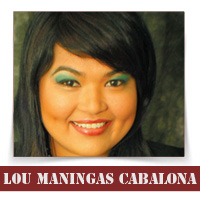
By: Lou Maningas Cabalona
I wanted a Bruno Mars’ cake! Almost half a year ago, I grabbed the few remaining Gold VIP seats for one of our favorite singer’s 24 Karat Magic Tour Concert in New Orleans and I have since been keeping them a secret from my husband. I wanted his birthday present – our NOLA Fall vacation – to be a big surprise with a matching beautiful 24K Magic cake!
As I was browsing through inspiration pics online, I found a Bruno-themed cookie that has his face hand painted in multi-color shadows on top of white sugar icing. It was pretty and it looked so good to eat but what caught my attention was his nose.
Yes, his Filipino nose.
Dominantly centered framed by his cool shades on each side, his pompadour above and his half smiling mysterious lips below, I was half surprised and pleasantly satisfied that the pastry artist did not feel the need to reduce its size here and there as magazines photographers chisel faces using Photoshop.
I looked at more pictures of Bruno and I saw the same. A few pictures showed it a little bit smaller but for the most part they kept his nose the same — wide and large, by international standards, beautiful, and in charge.
It was subtle, almost unnoticeable. But for a girl who’s used to seeing and hearing that the features I and my people are born with is not what’s considered the standard of beauty, it was silently empowering. It was a breath of affirmation that what we got is good enough.
No, let me rephrase that, what we got is good. Period.
It reminded me of one of my more recent visits back to the Philippines. I presume it was the peak of a marketing campaign for a skin whitening product that everywhere I went, I saw the slogan “Kutis Mayaman,” aptly translated as “Skin Like Wealthy People’s,” plastered next to ghostly pale celebrities all over Manila. Before me was an image of an unnaturally white Filipina staring down at a swarm of brown people, her wry smile saying “You have to look like me before you can be beautiful.” Or rich. Or successful. It was painful to see but inescapable. Even cable TV was flashing the same “Kutis Mayaman” advertisement every commercial break.
When I first saw the ad on a brightly lit billboard along C5 Expressway on the way to our Eastwood City condo the night we landed in Manila, I remember retorting loudly, “Kutis Kayumanggi IS kutis mayaman! It is the color of the Maharlikas,” although I really meant the Maginoos, the ancient Filipino royalty class.
I had to say it. Not to my family who was just excited to see us back in Manila but to rid myself of the negative, belittling message was it forcing in my mind.
A few days later, having breakfast with my sister-in-law, Jo, I saw yet another white-brain-washing Kutis ad on TV. I asked her in honest frustration, “Don’t Filipinos see that they are being prejudiced to themselves?” I continued to say, “In some way, that’s worse than people being racist to other kinds of people. We are racist to ourselves!”
My sister-in-law, in attempt to find a middle ground between my revelation and her thoughts, said something along the lines of, “Maybe, it is not so much being racist to ourselves but more on we just want to make ourselves better.”
Her words stopped me from saying anything more. It gave me more answers than what I wanted to hear.
Although I could not be more opposed to the notion that Filipinos/Filipinas would be better if they were whiter, I would be a hypocrite not to acknowledge that’s how it has always worked in the Philippines. It is generally (as in commonly, and widely) believed that the whiter, or in other words, the more non-traditionally Filipino looking someone is, the better looking they are. They are assumed to be more educated. They command more respect. They are more deserving of our attention. They deserve the job, the promotion, the trophy. They deserve the beautiful girl or the rich guy.
It has always been that way from my generation to my mother’s and my mother’s mother, maybe even before that.
I fondly remember my grandmother teasing, “Too bad, he wasn’t blonde and blue-eyed,” after she met my husband, then boyfriend, Baron. When she was still with us, she also told a cousin or two, that she knew she wanted to marry my grandfather, Lolo Jose, even if she ended up having to work for the family, because he was a mestizo and they would have good looking kids. Presumably, to have a better chance at life, however that happens.
She was a strong woman and I loved my Lola Tacing. A very successful woman entrepreneur and once an anti-Japanese messenger for Filipino guerillas during World War II, she was still a product of her time.
But our time is the present and the big question is: Will we let the world influence us to change who we really are or will we use our influence to change the world?
Back home in the US, there are Filipinos and other Asian Americans who work hard to break that stereotype. I am thankful for them and others who choose the latter.
At the beginning of May, the official Asian American and Pacific Islander Heritage Month, news of yet another white actor being cast to play a real-life Hawaiian war hero, Benehakaka “Ben” Kanahele in a new drama film set during World War II came out. But it does little to dampen the month-long celebration, if anything; it seems to fan the flames of long warranted change.
For every time, a Scarlett Johansen gets to fly on screen as a flawlessly beautiful Japanese cyborg cop named “Motoko Kusanagi,” there are Asian American actors that speak up bravely about “whitewashing” of Asian roles despite being faced with the threat of losing followers and friends for being “political”.
Every time a Matt Damon gets to flex his white man superpower muscles to save Chinese people from monster dragons, a la White Man’s Burden, there are writers and directors who would rather trade the security of a box office success with a creation that gives voice to authentic characters and their seldom heard-of stories of heroism, heartbreak and triumphs.
There are and will be Asian American leaders in the corporate world that answer to their call of nurturing and empowering other Asian and other minority professionals to break the “bamboo” ceiling in their various fields just like the folks at the National Association of Asian American Professionals who just concluded their Asian American Heritage Month (AAHM) celebration last May 5 in Chicago.
These are just some of the true heroes who have chosen to use their influence to change the world. And with my own voice and passion, I hope to continue echoing the same message whether it’s May or any other month.
Perhaps, in the long run, that maybe a more permanent and all-naturalle alternative to making our self and our future generations, “better.” ———–
Louella Maningas Cabalona is a singer, actor, and Senior Manager for Business Analytics, Sears Holdings. She is the lead singer of the Filipino Folk band, SamaSama Project; an active Board member of the League of Volunteers for Relief Expeditions and the Young Business United and is one of the inaugural delegates of the FYLPRO Immersion program of the Philippine Embassy in Washington DC. She is passionate about sharing Filipino culture in the modern world and actively supports all outstanding Filipinos around the globe. If you would like to connect, email louellarose@ gmail.com

Baron opening his birthday gift and his Bruno Mars 24K Gold Birthday cake.
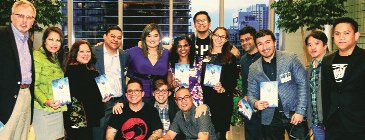
Guest Performers, SamaSama Project with some of the attendees of the NAAAP-Chicago Asian American Heritage Month Celebration at Blue Cross Blue Shield in Chicago.
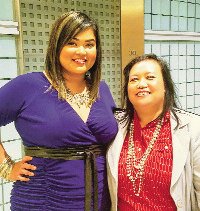
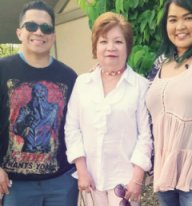
(1) Withh Rose Olea, President of NAAAP-Chicago and head organizer of the AAHM Celebration; (2) Our mima, Genia Cabalona (2nd from Left) surrounded by her Family, Orlando Cabalona, Baron and Louella.
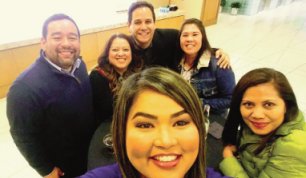
Louella taking a selfie with Nery Encarnacion, Agnes Cook, David Alonzo, Arleen Bonet and Toni Wunsch the NAAAP-Chicago Asian American Pacific Islanders Heritage Month Celebration
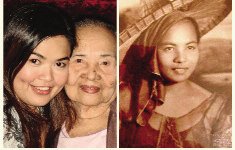
(1) With Constancia “Lola Tacing” Mesde; (2) Tacing in her younger years
 VIA Times – May 2017 Issue Vital News, Vibrant VIews for Asian Americans in Chicago & Midwest
VIA Times – May 2017 Issue Vital News, Vibrant VIews for Asian Americans in Chicago & Midwest

